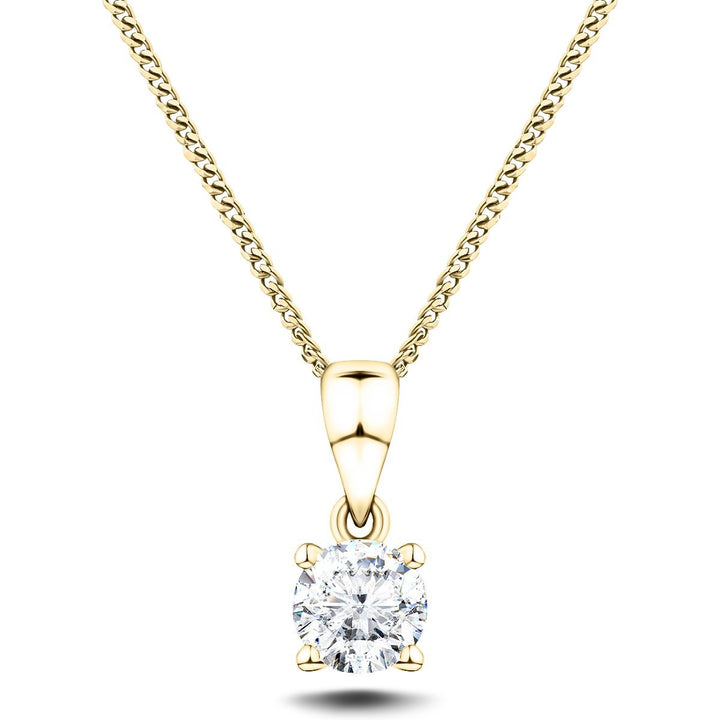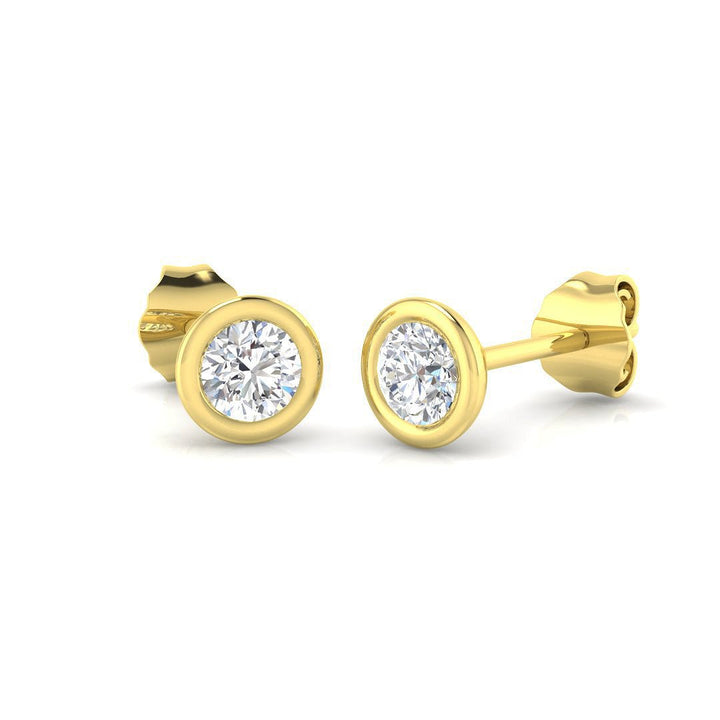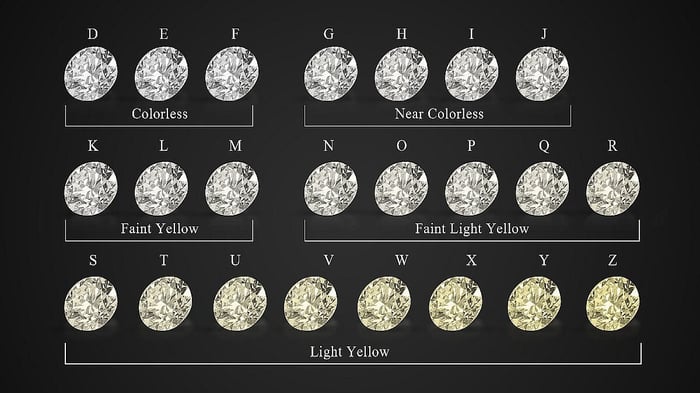The All Diamond Guide To Diamond Colour Grading
When we think of diamonds, we think of sparkling, brilliant and colourless gemstones, but the reality is not quite the same as what we imagine. In this article, we will take a look at diamond colour grading, how diamond colour is assessed and graded and give some tips about choosing the right grade of diamond for your next purchase.
Diamonds at jewellery stores may all appear to be colourless when you look at them. However, if you pay great attention, you'll see that many diamonds have faint shades of yellow, grey, or brown. The intensity of these colours influences the diamond's value and, thus, its cost when tuned into fine jewellery.
In general, a diamond will cost more the less colour it has. However, costs start to rise when the colour becomes slightly more intense than bright yellow (a grade named Fancy Light yellow). The price of Fancy Light yellow diamonds rises along with their intensity. The price per carat for larger diamonds with a very strong yellow hue has reached as much as £40,000. Smaller fancy diamonds are less costly per carat as they are more common than larger gemstones.
The GIA (Gemological Institute of America) created the most popular colour grading system in the 1950s; this element of their 4Cs grading system assigns colours alphabetical letters ranging from D to Z+. The 4Cs are almost universal, but some jewellers use an alternative system for describing and grading the diamonds they sell. Even if your jeweller employs a different system, he or she should be able to convert their proprietary grades into GIA grades. This enables comparisons to be made across different retail outlets.
The meaning of the GIA colour grades is illustrated in the diagram below. The same scale is used to grade brown and grey diamonds.
Diamond Cross Necklace with 1.00ct G/SI Diamonds in 18K White Gold

$1,982.00
$3,381.00
This elegant diamond cross pendant is a truly luxurious piece of fine UK hallmarked jewellery with G/SI quality. It is handcrafted with 1.00 carat of diamonds and fine 18K white gold. This diamond cross necklace makes a perfect gift -… read more
Diamond Colour Grades Used By GIA and Most Grading Laboratories
| DEF | GHIJ | KLM | NPQR | STUVWXYZ | Z+ |
| Colourless | Almost Colourless | Faint Yellow | Very Light Yellow | Light Yellow | Fancy Light Yellow |
D is the most expensive colour, while N through Z (the darker hues) are the least expensive in terms of cost. Due to their rarity and strong demand, the most expensive diamond colour grades are D, E, and F. The differences in colour between the classes are so subtle that the typical customer cannot distinguish between a D and F colour grade. However, depending on their size and quality, the cost difference between D and F colourless diamonds may range from 10% to 35%. To evaluate colour grades, experts must use comparison stones, and even then, it may be challenging to tell a D from an E or an E from an F colourless diamond.
Stones with a grade between G and J will satisfy your needs if you're looking to get a diamond that appears colourless in normal lighting and to untrained eyes. The distinction between colourless and nearly colourless grades cannot be easily seen when mounted in jewellery. Consider buying a diamond in the pale yellow to light yellow range if you prefer warmer hues. Bear in mind that it is common for buyers to choose the colour of the precious metal to enhance the colour of the diamond to their taste. Yellow gold gives a warmer, yellowish hue and white gold or platinum tend to make a slightly yellow diamond look whiter, downplaying the yellow hue.
Diamonds with D to J colours are often referred to as white diamonds in the jewellery trade. Unfortunately, "white" is an inaccurate colour description. It is more correct to refer to these gemstones as colourless. The phrase "white diamond" is problematic because some very hazy diamonds are indeed white. But remember that if a trade expert says one diamond is whiter than another, it usually means the whiter stone has a higher colour grade.
Because it can be hard to discern the hue of a diamond in isolation, when your budget is tight, it is preferable to sacrifice colour rather than the quality of the cut and transparency.
What Colour Grade Should You Choose?
It doesn't matter what hue you choose if you're purchasing the diamond for personal enjoyment as long as you like it, and it suits your skin tone. You're better off choosing an untreated natural diamond in the D to F range if you're purchasing the diamond for investment purposes.
Yellow-tinged diamonds (GIA grades K to Z) are relatively common. As a result, they are cheaper than colourless diamonds and are often used in budget jewellery. This does not imply that they are less capable. Some people prefer a yellow tint since it gives off a warm vibe and may complement their skin tone. These slightly yellow diamonds are also used in jewellery sold at high-end retailers.
At All Diamond, most of our diamonds are of G colour grade. In our opinion, this is the sweet spot for value and colour grade. There is no point in paying for a colour grade that nobody but an expert will ever see, but most buyers want a diamond that is as colourless as possible for reasons of pride of ownership. G colour grade diamonds enable the buyer to have a diamond that appears colourless without paying the premium price of a higher graded stone.
Comparing Diamond Colour grades
You'll likely need to compare jewellery items with the two qualities side by side in order to distinguish between colourless and faint yellow diamonds when they are placed in jewellery. The colourless diamonds will create more of a contrast and will likely appear brighter, while the yellowish diamonds would blend in more with the gold. The colour variation is more noticeable when viewing loose diamonds through the side with the table (top facet) down.
In the K to Z range, not all diamonds are yellowish. Some are greyish or brownish. They are rated using the same system as yellowish diamonds with a few adjustments. Brown diamonds that are darker than K are described by GIA graders with a letter grade and a coloured diamond grade, such as Faint brown for K to M, Very Light brown for N to R, and Light brown for S to Z. Consequently, a brown diamond rated at L would be considered L-Faint brown (a.k.a. top light brown in the trade). The GIA does this to distinguish between yellow and brown stones in the typical range that are darker than K. Normally, light brown diamonds are less expensive than light yellow diamonds. Champagne diamonds is a marketing name for diamonds with a little brownish tinge. Cognac diamonds or fancy cognacs are two names for deeper brown diamonds.
Diamond Solitaire Necklace 1.00ct G/SI in 18k Yellow Gold

$8,522.00
$16,155.00
An elegant and timeless necklace that's a great choice for a gift, a party, or just for everyday wear. This stunning 18k yellow gold necklace has a simple yet elegant design that is the perfect choice for any occasion. A… read more
The Objectivity of Diamond Colour Grading
Contrary to popular belief, colour ratings are not as objective as they may be. The colour grade can be contested even when it was assigned by the GIA, a highly regarded diamond grading laboratory. A strong sign that gemstone grading is somewhat subjective is that most diamond grading labs do not guarantee their grades or accept blame for any grading faults. There are tools for measuring colour, but grading is typically done by eye because the key lies in how the individual sees the colour. The following are a few issues that make it challenging for people to evaluate colour objectively.
1)Master stones are often smaller than the stone that the examiner is grading. Comparing stones of different sizes might be misleading because smaller stones make it harder to determine the hues within the stone.
3) Colour-zoned diamonds have two grades of colour within the single stone. When this happens, the colour grade must be chosen, or an average of the grades reported.
4) Sometimes, diamond inclusions impact colour perception.
5) The master stone proportions may differ from the graded stone, causing colour variances.
Despite the intricacy of diamond grading, experts tend to agree on the colour grade assigned to a particular gemstone. On the other hand, buyers and sellers are more likely to disagree, especially when the hue is between grades. Thousands of pounds may be at stake in such cases, giving an incentive for disagreement!
Do colour grades lack objectivity? Although there is an element of subjectivity, skilled diamond graders can consistently agree about the grade a diamond should be given, which can only occur when the judging criteria and processes are adequately objective.
Colour grading standards make comparison shopping easier for the consumer. You may negotiate purchases and discuss colour with dealers in other towns or even countries. When comparing pricing, keep in note that some dealers falsify colour grading to make their gems look better. Misrepresented colour grades are difficult for most consumers to spot – especially if the diamond is already mounted in a setting.
Request a diamond grading report from a reputable diamond grading organisation for significant purchases. Gemological labs know the limitations of diamond grading, so they have multiple people analyse each diamond. Even with a grading report, you need to know the limitations of the process! At the least, a reputable diamond grading report helps to keep sellers honest!
A Difference In Opinion Does Not Mean Somebody Is Dishonest or Mistaken!
If a jeweller says a stone is G, and a gem lab says it's H, don't think the jeweller is unskilled or dishonest. You should shop elsewhere if a jeweller calls an unmounted K-colour diamond a G-colour. Knowing the limits of colour grading can also help you understand that some jewellers’ pricing may appear higher than others when they're lower due to stricter grading. This is why many jewellers avoid phone quotes. If they're strict graders, their prices will be unfairly contrasted to stores that over grade. When an appraiser or gem lab grades a diamond's colour, remember that it's subjective; it represents an expert’s opinion.
Diamond Rub Over Stud Earrings 0.40ct G/SI Quality in 18k Yellow Gold

$1,171.00
$1,866.00
These sparkling diamond stud earrings with a classic rub-over setting in luxurious 18k yellow gold are the perfect romantic gift for that special someone in your life. If you're treating yourself, you can be sure they will augment all of… read more
All Diamond Colour Grading
Most of the diamonds in our UK-designed and handcrafted jewellery collections are of G colour grade. We do this because, in our opinion, this is the sweet spot of colour and price. If you choose a lower-graded diamond, you are more likely to see a hint of yellow in the gem. If you choose a higher colour graded diamond, you may not notice a difference in colour, but you will certainly pay much more for it!
Many of our diamond jewellery items are provided with an individual diamond grading report for the central gemstone. It is not practical to do so with very small diamonds, and most grading labs will not accept small diamonds for this reason.
Our craftsmen are careful to use diamonds that offer a good match, and within each piece of jewellery, all the diamonds will have been assessed as being of the same colour grade and a good match for each other.
Please check out our range of fine diamond jewellery. Every piece we sell comes with an attractive jewellery box and has a lifetime workmanship guarantee. In addition, we supply an insurance valuation report for every item we sell so that you can get the right insurance coverage for your needs.
We look forward to helping you to choose your next piece of fine diamond jewellery – remember to use the chat box on every page if you have any questions that you would like to ask!




